- 1School of Physics and Mechanical Electrical & Engineering, Hubei University of Education, Wuhan, China
- 2Institute of Astronomy and High Energy Physics, Hubei University of Education, Wuhan, China
- 3Wuhan Textile University, Wuhan, China
We employed the dynamically constrained phase space coalescence model to study the
1 Introduction
Hadron spectroscopy is a field replete with frequent discoveries and surprises, and the theoretical complexities associated with understanding the strong interaction in the color confinement regime make the field even more fascinating. A very successful classification scheme for hadrons in terms of their valence quarks and antiquarks was independently proposed by Murray Gell-Mann [1] and George Zweig [2] in 1964. This classification, known as the quark model, essentially divides hadrons into two major families: mesons (quark-antiquark) and baryons (three-quarks). Theoretically, the basic theory of the strong interaction, quantum chromodynamics (QCD), allows for the existence of exotic hadrons beyond the conventional picture.
The first quarkonium-like state, the
The production yields of exotic states in high-energy collisions, which are expected to be strongly influenced by their internal structure, have received increasing attention [10–18]. The internal structure of exotic hadrons is still under debate. They are assumed to be loosely bound hadronic molecule, a compact tetraquark, or just a kinematic effect such as the triangle singularity, etc [8, 9]. The internal structure and interactions of compact multiquark states and hadronic molecular states have been extensively studied. The former are bound by the strong interaction directly, while the latter are bound by residual strong interaction [8, 9, 19].
The abundant number of quarks and antiquarks for both light and heavy flavors suggests that heavy-ion collisions provide an ideal environment for exotic hadron production, compared to electron-positron and proton-proton (or antiproton) collisions. The first evidence for the
2 Model
The PACIAE model [20–22] is a parton and hadron cascade model based on PYTHIA [23]. It has been successfully used to describe particle multiplicity, transverse momentum, rapidity distributions, and other observables in high-energy collisions [17, 24–27]. The PACIAE Monte-Carlo (MC) simulation provides a complete description of one collision, which includes the partonic initialization stage, partonic rescattering stage, hadronization stage, and the hadronic rescattering stage. For nucleon-nucleon (NN) collisions, compared to PYTHIA, the partonic and hadronic rescattering are introduced before and after the hadronization, respectively. The initial-state free parton is produced by breaking the strings of quarks, antiquarks, and gluons formed in the Pb-Pb collision with the PACIAE model. The parton rescattering is further considered using the
The DCPC model was proposed to study production of the light nuclei in
Here,
Therefore, the yield of an
where,
The
The DCPC model has been successfully applied to different collision systems at RHIC and LHC, including
3 Result
In this work, we produce the
In the production of final states particles with PACIAE, the impact parameter
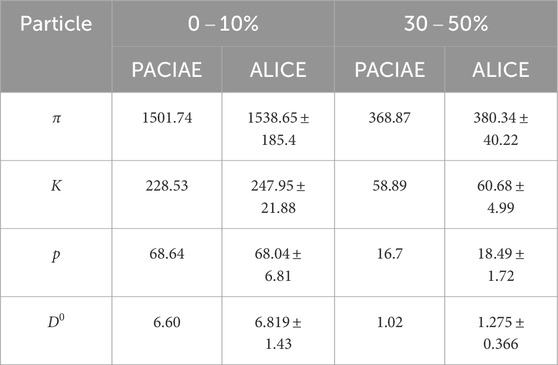
Table 1. The comparisons of the yield of
In this work, the
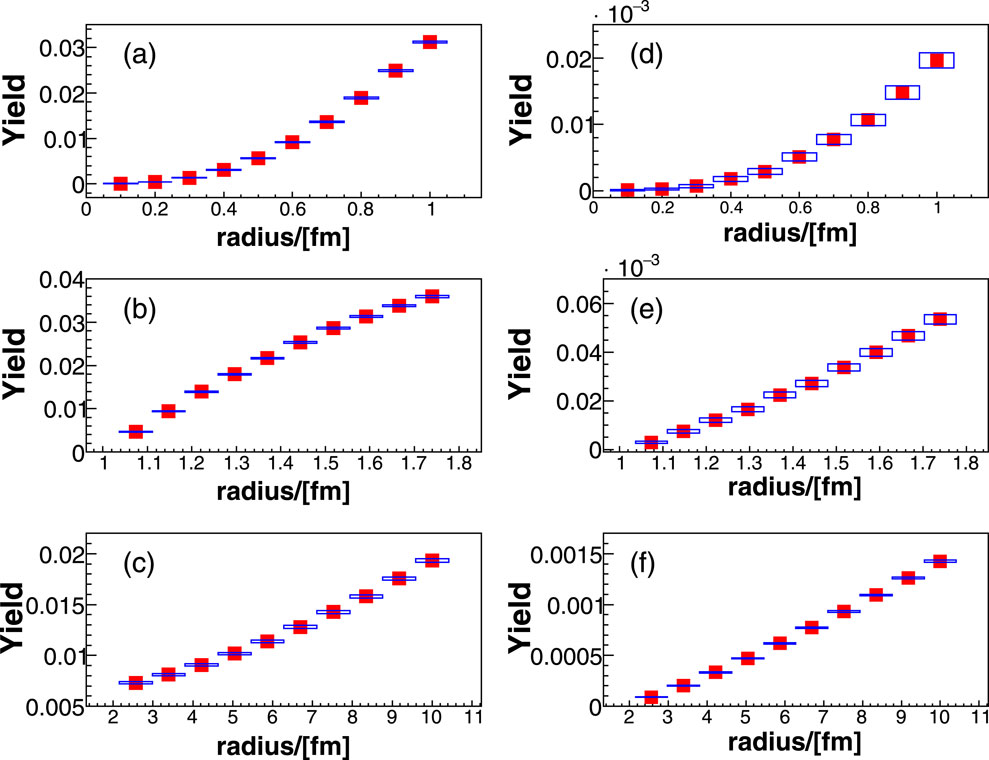
Figure 1. Radius distributions of
Then, we calculate the yields of three structures of the
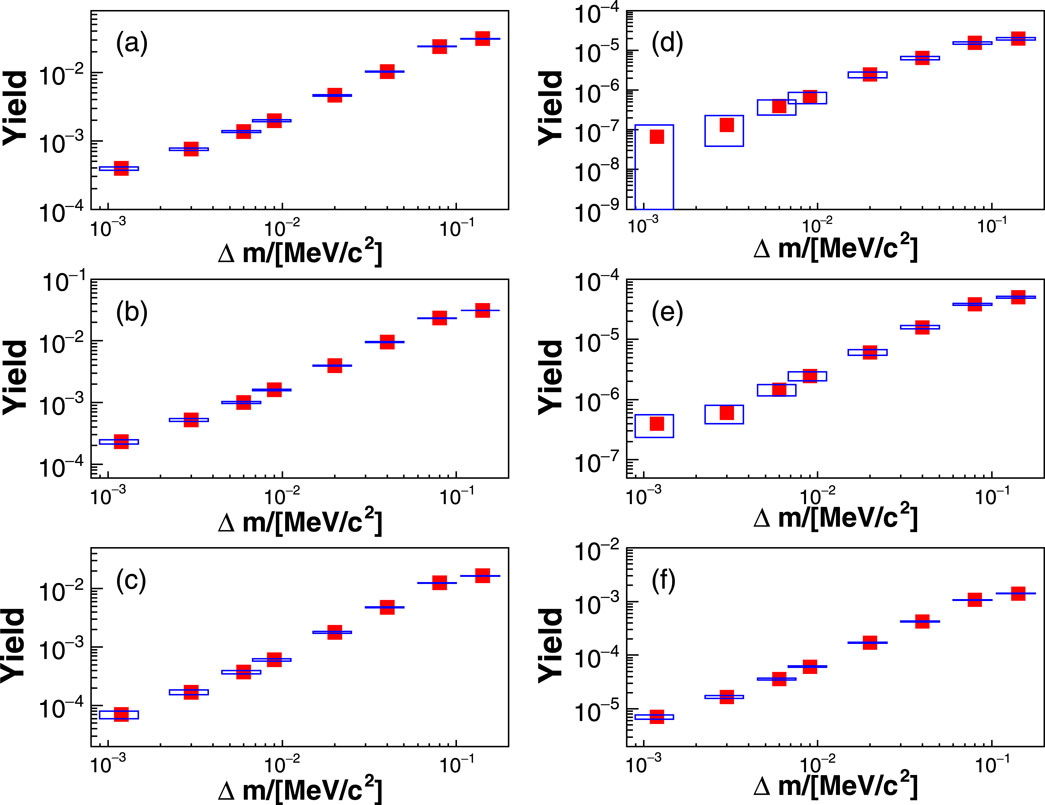
Figure 2. Mass distributions of the
As a reasonable prediction, we can predict the yields of the
Moreover, we calculate the transverse momentum distribution of the tetraquark, nuclear-like and molecular states the
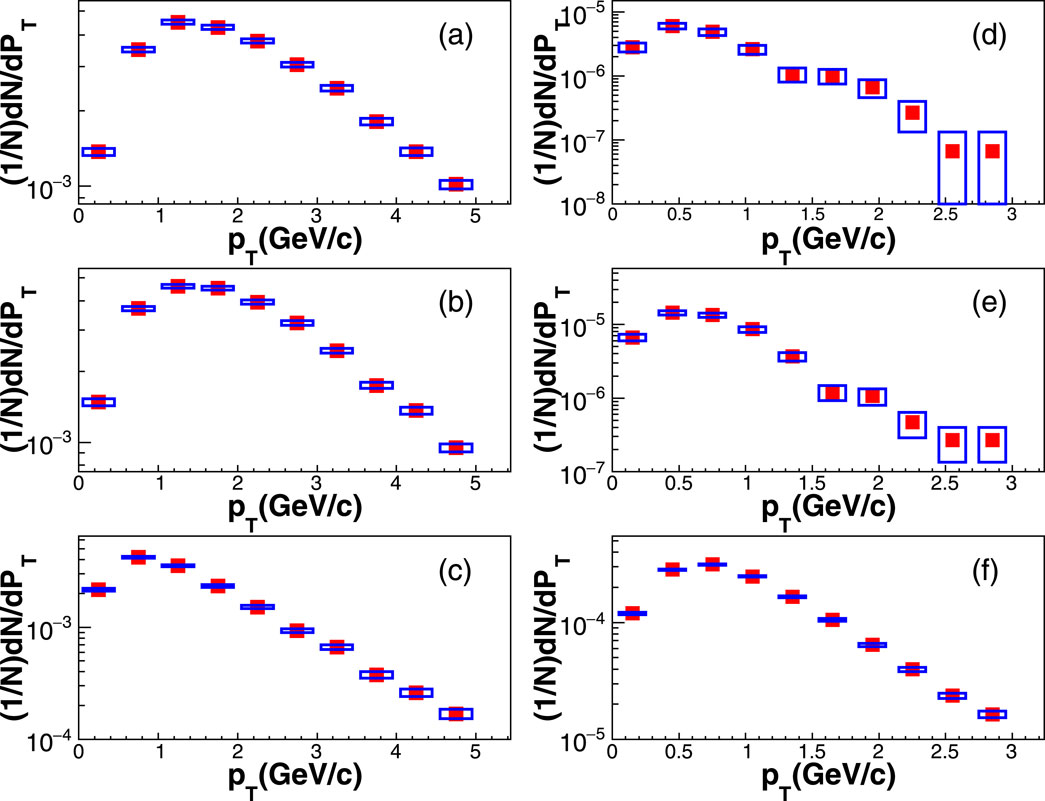
Figure 3. The transverse momentum distributions of the
In Figure 3, we show the predicted pT-differential yields of the tetraquark, nuclear-like and molecular states of the
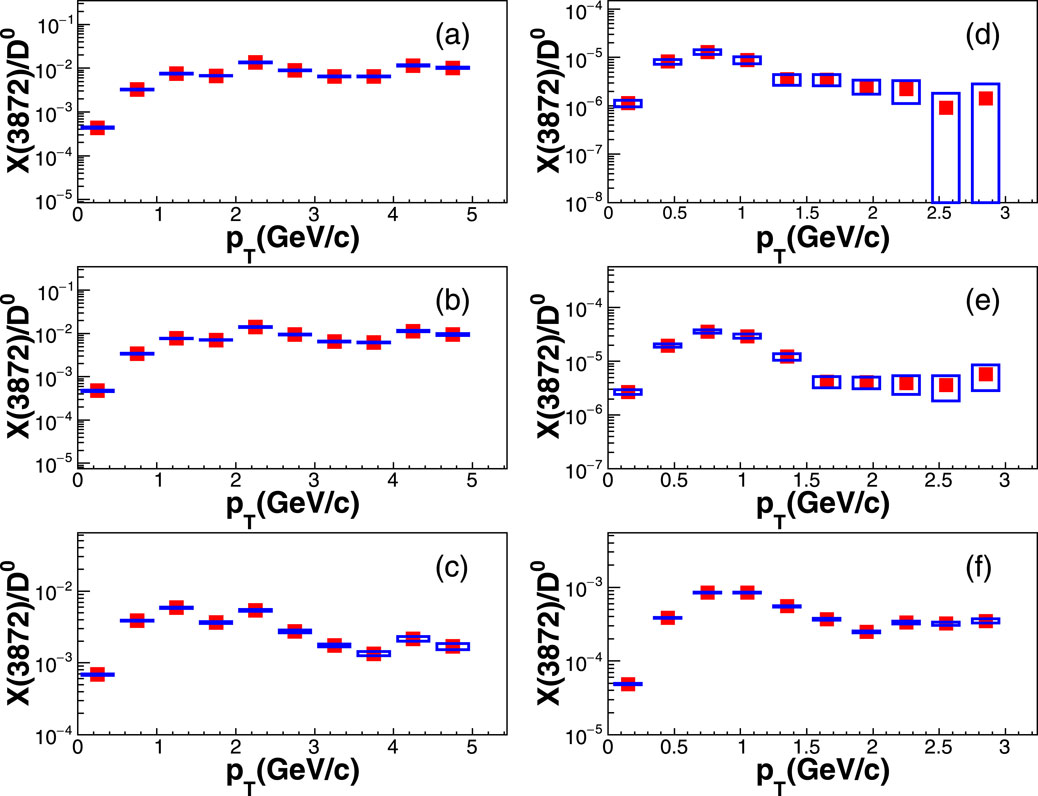
Figure 4. The yield ratio for
From Figure 4, we observe that the yield ratio for the
4 Conclusion
In this paper, we study the production of the
Data availability statement
The original contributions presented in the study are included in the article/supplementary material, further inquiries can be directed to the corresponding author.
Author contributions
HX: Conceptualization, Data curation, Formal Analysis, Investigation, Methodology, Software, Validation, Writing – original draft, Writing – review and editing. ZS: Data curation, Resources, Software, Writing – review and editing. NY: Conceptualization, Funding acquisition, Project administration, Writing – review and editing. ZZ: Investigation, Methodology, Validation, Writing – review and editing.
Funding
The author(s) declare that financial support was received for the research and/or publication of this article. This work is supported by the Scientific Research Foundation of Hubei University of Education for Talent Introduction (No. ESRC20230002 and No. ESRC20230007) and Research Project of Hubei Provincial Department of Education (No. D20233003 and No. B2023191).
Conflict of interest
The authors declare that the research was conducted in the absence of any commercial or financial relationships that could be construed as a potential conflict of interest.
Generative AI statement
The author(s) declare that no Generative AI was used in the creation of this manuscript.
Publisher’s note
All claims expressed in this article are solely those of the authors and do not necessarily represent those of their affiliated organizations, or those of the publisher, the editors and the reviewers. Any product that may be evaluated in this article, or claim that may be made by its manufacturer, is not guaranteed or endorsed by the publisher.
References
1. Gell-Mann M. A schematic model of baryons and mesons. Phys. Lett. (1964) 8:214–5. doi:10.1016/s0031-9163(64)92001-3
2. Zweig G, An SU3 model for strong interaction symmetry and its breaking. Version 1 10.17181/CERN-TH-401 (1964).
3. Choi SK, Olsen SL, Abe T, Abe I, Adachi I, Aihara K, et al. Observation of a narrow charmonium-like state in exclusive B± → K±π+π−J/ψ decays. Phys. Rev. Lett. (2003) 91:262001. doi:10.1103/PhysRevLett.91.262001
4. Aubert B, Barate R, Boutigny D, Couderc F, Gaillard JM, Hicheur A, et al. Study of the B → J/ψK−π+π− decay and measurement of the B → X(3872)K− branching fraction. Phys. Rev. D (2005) 71:071103. doi:10.1103/PhysRevD.71.071103
5. Acosta D, Affolder T, Ahn MH, Akimoto T, Albrow MG, Ambrose D, et al. (CDF), Observation of the narrow state X(3872) → J/ψπ+π− in
6. Abazov VM, Abbott B, Abolins M, Acharya BS, Adams DL, Adams M, et al. Observation and Properties of the X(3872) Decaying to J/ψπ+π− in
7. Navas S, Amsler C, Gutsche T, Hanhart C, Hernández-Rey JJ, Lourenço C, et al. Review of particle physics*. Phys. Rev. D (2024) 110:030001. doi:10.1103/PhysRevD.110.030001
8. Liu MZ, Pan YW, Liu ZW, Wu TW, Lu JX, Geng LS. Three ways to decipher the nature of exotic hadrons: multiplets, three-body hadronic molecules, and correlation functions. Phys. Rept. (2025) 1108:1–108. doi:10.1016/j.physrep.2024.12.001
9. Chen H-X, Chen W, Liu X, Liu Y-R, Zhu S-L. An updated review of the new hadron states. Rept. Prog. Phys. (2023) 86:026201. doi:10.1088/1361-6633/aca3b6
10. Cho S, Furumoto T, Hyodo T, Jido D, Ko CM, Lee SH, et al. Identifying multiquark hadrons from heavy ion collisions. Phys. Rev. Lett. (2011) 106:212001. doi:10.1103/physrevlett.106.212001
11. Cho S, Hyodo T, Jido D, Ko CM, Lee SH, Maeda S, et al. Exotic hadrons from heavy ion collisions. Prog. Part. Nucl. Phys. (2017) 95:279–322. doi:10.1016/j.ppnp.2017.02.002
12. Hu Y, Liao J, Wang E, Wang Q, Xing H, Zhang H. Production of doubly charmed exotic hadrons in heavy ion collisions. Phys. Rev. D (2021) 104:L111502. doi:10.1103/physrevd.104.l111502
13. Chen CH, Xie YL, Xu HG, Zhang Z, Zhou DM, She ZL, et al. Exotic states Pc(4312), Pc(4440), and Pc(4457) in pp collisions at
14. Esposito A, Ferreiro EG, Pilloni A, Polosa AD, Salgado CA. The nature of X(3872) from high-multiplicity pp collisions. Eur. Phys. J. C (2021) 81:669. doi:10.1140/epjc/s10052-021-09425-w
15. Chen BY, Jiang L, Liu XH, Liu YP, Zhao JX. X(3872) production in relativistic heavy-ion collisions. Phys. Rev. C (2022) 105:054901. doi:10.1103/physrevc.105.054901
16. Sirunyan AM, Tumasyan A, Adam W, Ambrogi F, Bergauer T, Dragicevic M, et al. Evidence for X(3872) in Pb-Pb collisions and studies of its prompt production at
17. Xu HG, She ZL, Zhou DM, Zheng L, Kang XL, Chen G, et al. Investigation of exotic state X(3872) in pp collisions at
18. Zhang H, Liao JF, Wang EK, Wang Q, Xing HX. Deciphering the nature of X(3872) in heavy ion collisions. Phys. Rev. Lett. (2021) 126:012301. doi:10.1103/physrevlett.126.012301
19. Grinstein B, Maiani L, Polosa AD. Radiative decays of X(3872) discriminate between the molecular and compact interpretations. Phys. Rev. D (2024) 109:074009. doi:10.1103/physrevd.109.074009
20. Sa BH, Zhou DM, Yan YL, Li XM, Feng SQ, Dong BG, et al. PACIAE 2.0: an Updated parton and hadron cascade model (program) for the relativistic nuclear collisions. Comput. Phys. Commun. (2012) 183:333–46. doi:10.1016/j.cpc.2011.08.021
21. Sa BH, Zhou DM, Yan YL, Dong BG, Cai X. PACIAE 2.1: an updated issue of the parton and hadron cascade model PACIAE 2.0. Comput. Phys. Commun. (2013) 184:1476–9. doi:10.1016/j.cpc.2012.12.026
22. Zhou DM, Yan YL, Li XL, Li XM, Dong BG, Cai X, et al. An upgraded issue of the parton and hadron cascade model, PACIAE 2.2. Comput. Phys. Commun. (2015) 193:89–94. doi:10.1016/j.cpc.2015.01.022
23. Sjöstrand T, Mrenna S, Skands P. Pythia 6.4 physics and manual. J High Energ Phys (2006) 2006:026. doi:10.1088/1126-6708/2006/05/026
24. Chen G, Yan YL, Li DS, Zhou DM, Wang MJ, Dong BG, et al. Antimatter production in central Au+Au collisions at
25. Yan YL, Dong BG, Zhou DM, Li XM, Sa BH. Theoretical analysis for the apparent discrepancy between
26. Zhou DM, Zheng L, Yan YL, Song ZH, Chen G, Li XM, et al. Impact of single string structure and multiple string interaction on strangeness production in Pb + Pb collisions at
27. Zheng L, Zhou DM, Yin ZB, Yan YL, Chen G, Cai X, et al. Effect of single string structure and multiple string interaction on strange particle production in pp collisions at
28. Combridge BL, Kripfganz J, Ranft J. Hadron production at large transverse momentum and QCD. Phys Lett B (1977) 70:234–8. doi:10.1016/0370-2693(77)90528-7
29. Yan YL, Chen G, Li XM, Zhou DM, Wang MJ, Hu SY, et al. Predictions for the production of light nuclei in pp collisions at
30. Stowe K. An introduction to thermodynamics and statistical mechanics. 2nd ed. Cambridge University Press (2007).
31. Kubo R, Ichimura H, Usui T, Hashizume N. Statistical mechanics: an advanced course with problems and solutions. North-Holland Pub. Co (1965).
32. Ragab NA, She ZL, Chen G. The production of light (anti-)nuclei and (anti-)hypertriton in pp collisions at
33. Xu HG, Chen G, Yan YL, Zhou DM, Zheng L, Xie YL, et al. Study on the
34. Wu CT, She ZL, Peng XY, Kang XL, Xu HG, Zhou DM, et al. Study on the structure of exotic states χc1(3872) via beauty-hadron decays in pp collisions at
35. Zhang Z, Zheng L, Chen G, Xu HG, Zhou DM, Yan YL, et al. The study of exotic state
36. Liu FX, Chen G, She ZL, Zheng L, Xie YL, Dong ZJ, et al.
37. Liu FX, Chen G, Zhe ZL, Zhou DM, Xie YL. Light (anti)nuclei production in Cu+Cu collisions at
38. Chen G, Chen H, Wu J, Li DS, Wang MJ. Centrality dependence of light (anti)nuclei and (anti)hypertriton production in Au+Au collisions at
39. Chen G, Chen H, Wang JL, Chen ZY. Scaling Properties of light (anti)nuclei and (anti)hypertriton production in Au+Au collisions at
40. Dong ZJ, Chen G, Wang QY, She ZL, Yan YL, Liu FX, et al. Energy dependence of light (anti)nuclei and (anti)hypertriton production in the Au-Au collision from
41. She ZL, Chen G, Liu FX, Zheng L, Xie YL. Study of nuclear modification factors of (anti-)hadrons and light (anti-)nuclei in Pb-Pb collisions at
42. She ZL, Gang C, Xu HG, Zeng TT, Li DK. Centrality dependence of light (anti)nuclei and (anti)hypertriton production in Pb-Pb collisions at
43. Acharya S, Adamová D, Adhya SP, Adler A, Adolfsson J, Aggarwal MM, et al. Production of charged pions, kaons, and (anti-)protons in Pb-Pb and inelastic pp collisions at
44. Acharya S, Adamová D, Adler A, Adolfsson J, Agnello M, Agrawal N, et al. Prompt D0, D+, and D*+ production in Pb–Pb collisions at
Keywords: heavy ion collision, exotic hadron, hadronic molecular state, tetraquark state, nuclear-like state
Citation: Xu H, She Z, Yu N and Zhang Z (2025) Production of the
Received: 01 April 2025; Accepted: 20 June 2025;
Published: 09 July 2025.
Edited by:
Shahin Agaev, Baku State University, AzerbaijanReviewed by:
Atif Arif, COMSATS University, PakistanFabrizio Grosa, European Organization for Nuclear Research (CERN), Switzerland
Copyright © 2025 Xu, She, Yu and Zhang. This is an open-access article distributed under the terms of the Creative Commons Attribution License (CC BY). The use, distribution or reproduction in other forums is permitted, provided the original author(s) and the copyright owner(s) are credited and that the original publication in this journal is cited, in accordance with accepted academic practice. No use, distribution or reproduction is permitted which does not comply with these terms.
*Correspondence: Ning Yu, bmluZy55dWNoaW5hQGdtYWlsLmNvbQ==
 Hongge Xu1,2
Hongge Xu1,2 Ning Yu
Ning Yu Zuman Zhang
Zuman Zhang